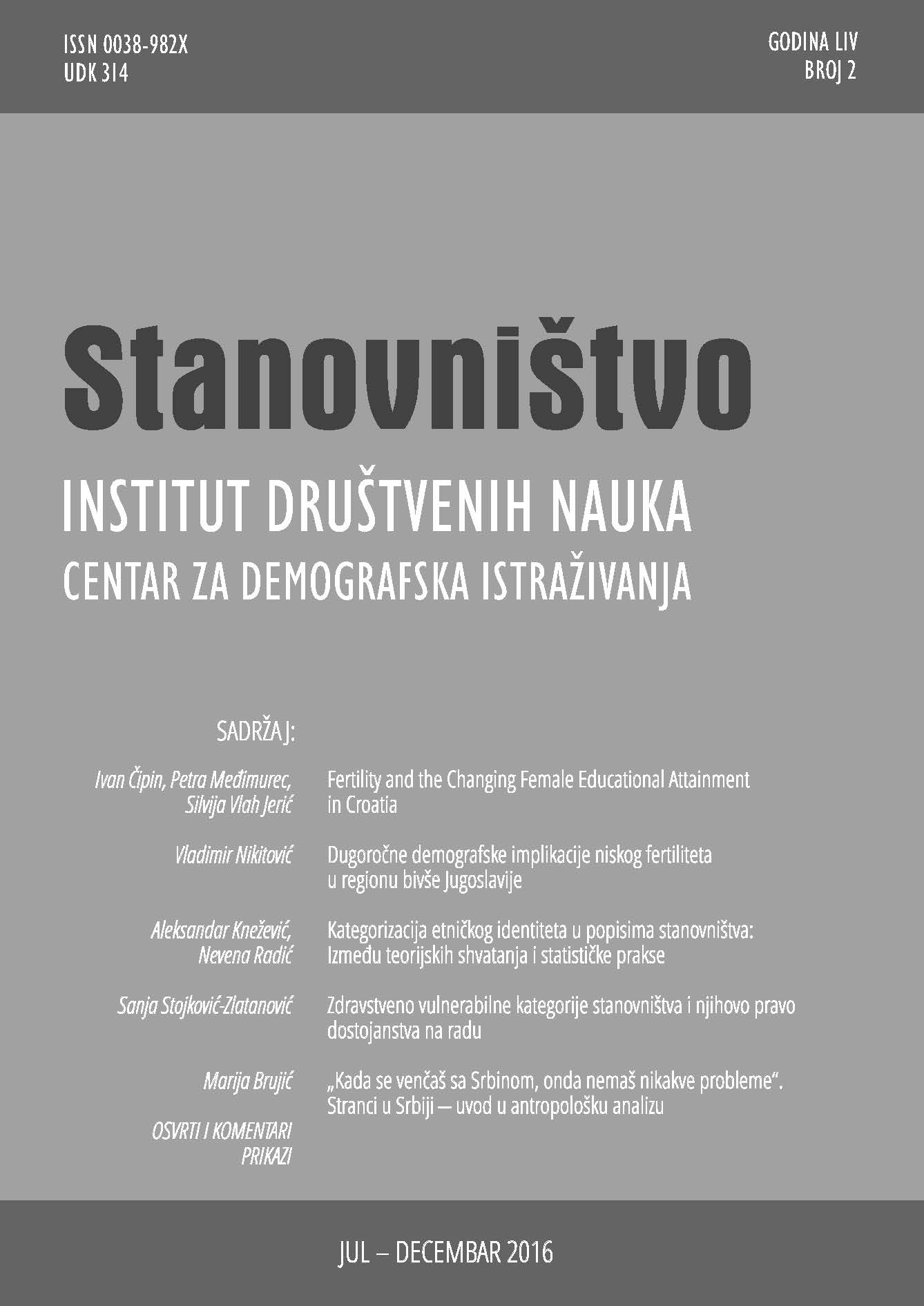Dugoročne demografske implikacije niskog fertiliteta u regionu bivše jugoslavije
Long-term Effects of Low Fertility in the Region of Former Yugoslavia
Author(s): Vladimir NikitovićSubject(s): Demography and human biology
Published by: Институт друштвених наука
Keywords: low fertility; the migration cycle model; Yugoslavia; population projections; UN WPP2015
Summary/Abstract: After the dissolution of the socialist Yugoslavia (SFRY) in 1991, the quality and availability of demographic and migration statistics in the region as a whole, and especially in some of its parts are deteriorated. In addition, census rounds are not being held regularly throughout the region as of 1991. Thus, producing population projections has become rather challenging in comparison to the period of SFRY. This paper made an effort in order to overcome obstacles in terms of historic data and jump-off projection values for the whole region in accordance with adjusted data from national records. Until 1991, population of the region had been increasing almost linearly. Although SFRY was characterized by significant sub-regional differences in terms of the beginning and the pace of demographic transition, the current total fertility rate throughout the region is below 2.1. The aim of the paper is to consider the longterm implications of low fertility and whether in this respect there would be a demographic homogenization of the region. For that purpose, we relied on the UN WPP2015 model used by the UN Population Division for producing its 2015 World Population Prospects. It enabled several important features from the viewpoint of the main tasks of the paper: the methodologically consistent datasets on main demographic indicators, probabilistic approach for modelling and forecasting fertility and mortality, the opportunity to adjust initial datasets for known issues on data quality (Serbia, Kosovo, Bosnia & Herzeg.), and ability to adjust data distribution according to the former administrative division of SFRY. The last one was of particular importance as it allowed us to take into account the well-known diversity of fertility patterns in Serbia (Vojvodina, Central Serbia and Kosovo), and to make a distinction in projection results between the sub-regions differed by the onset and tempo of fertility transition. The UN concept of post-transition recovery of total fertility rate is lying behind the hypotheses of future TFR. According to the model, Slovenia and Vojvodina has been already entered the post-transitional phase. Central Serbia and Macedonia are first to join them (as of 2020), followed by Croatia and Bosnia & Herzeg. (2025), and Montenegro (2030). However, the fertility transition in Kosovo could last until 2070. The greatest chance (median distribution of the simulated trajectories) is that TFR in the SFRY region will converge to the levels projected for Southern Europe (1.8) in 2100, except in Slovenia (1.89). Hypotheses on migration in deterministic manner were based on the “migration cycle model” introduced by Fassmann and Reeger (2012), which assume that all of Europe will eventually experience the transition to net immigration. Since the strategic objectives of all governments in the region are consistent when it comes to joining the EU, it is taken as a pivotal condition for a hypothesis on the migration transition. The symbolic turning point in the transition process in the region (2035) implies that the whole region will become the part of the EU by then. Kosovo is assumed to be the only territory not able to achieve the net immigration during The greatest chances (median of the distribution) are that the population in the region of SFRY will be reduced by 16.9% between 2015 and 2055, which puts this region among the ones that are going to experience the strongest decrease (over 15%) in global terms - mainly countries of the former Eastern bloc and Japan. According to the median of prediction intervals, a sharp decline is expected in Vojvodina (31.7%), Cent. Serbia (27.2 %), Bosnia & Herzeg. (22.0%), and Croatia (18.9%), which is similar to the countries that were expected to experience the greatest population decrease in the world by 2050 Bulgaria, Romania, Ukraine, and Moldova. The region reversal to the historic population maximum of 1990 seems to be not possible even in conditions of the above replacement fertility. A zone of depopulation emerged along the eastern rim of the EU, which, according to the UN model, is the most prominent depopulation zone in global terms. Prediction intervals indicate that by the mid-century, with the exception of Kosovo, only Slovenia has some chances (35%) to maintain the current population size. However, to return to its maximum population by 2100 some chance has only Slovenia (almost 30%), and only minimal Montenegro (8%), and Kosovo (5%). Old-age dependency ratio in the SFRY region is likely to double by the mid-century, while the prediction intervals suggest that even a return to the current unfavourable level is outside of the range of possible outcomes throughout the region. It is the most important long-term demographic implication of low fertility. Yet, that rise has its limits. Therefore, the next four decades will be the most challenging period of getting used to the new demographic reality, which in view of the modern concept of population policy (quality before quantity) is not necessarily bad. One of the conclusions is that the significant increase in the total fertility rate, i.e. up to and around the replacement level of 2.1, which current official projections (Cent. Serbia, Vojvodina, Montenegro, and Croatia) consider as the ultimate objective of population policy, is far beyond the possible outcomes.
Journal: Stanovništvo
- Issue Year: 54/2016
- Issue No: 2
- Page Range: 27-58
- Page Count: 32
- Language: Serbian

